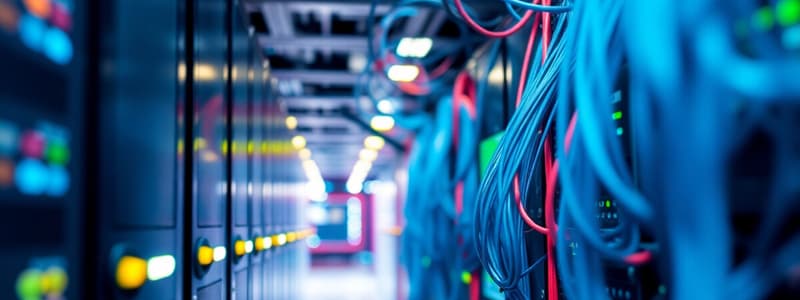Podcast
Questions and Answers
What is the preferred way to access the Internet for most users?
What is the preferred way to access the Internet for most users?
- Fiber-optic service
- Broadband (correct)
- Dial-up Internet access
- Satellite Internet
What type of device is primarily used to establish WiFi at home?
What type of device is primarily used to establish WiFi at home?
- Network-attached storage (NAS)
- Router (correct)
- Switch
- Modem
Which wireless standards may impact the speed and range of a home network?
Which wireless standards may impact the speed and range of a home network?
- Bluetooth and Wi-Fi 3
- Wi-Fi 4 and Wi-Fi 5 (correct)
- Ethernet and DSL
- Fiber-optic and Satellite
What is one possible consequence of walls and large metal objects in relation to WiFi signals?
What is one possible consequence of walls and large metal objects in relation to WiFi signals?
Which of the following types of connection is NOT commonly associated with broadband?
Which of the following types of connection is NOT commonly associated with broadband?
What is a data plan in the context of Internet connectivity?
What is a data plan in the context of Internet connectivity?
What type of device acts like a traffic signal on a network?
What type of device acts like a traffic signal on a network?
Which of the following is a specialized device for centralized data storage and access?
Which of the following is a specialized device for centralized data storage and access?
What type of Internet access might be used primarily in rural or mountain areas?
What type of Internet access might be used primarily in rural or mountain areas?
What should you consider if your ISP-provided router is older?
What should you consider if your ISP-provided router is older?
What is a major disadvantage of setting up a computer network?
What is a major disadvantage of setting up a computer network?
Which term refers to the actual speed at which data is transferred over a network?
Which term refers to the actual speed at which data is transferred over a network?
What type of network is specifically located within a person's home?
What type of network is specifically located within a person's home?
Which of the following is NOT a benefit of networking computers?
Which of the following is NOT a benefit of networking computers?
What term describes the maximum speed at which data can be transmitted in a network?
What term describes the maximum speed at which data can be transmitted in a network?
Which type of network is designed for communication among devices close to one person?
Which type of network is designed for communication among devices close to one person?
What is necessary for computers to communicate in a network?
What is necessary for computers to communicate in a network?
Which of the following is a characteristic of a Local Area Network (LAN)?
Which of the following is a characteristic of a Local Area Network (LAN)?
What should be considered before creating a home network?
What should be considered before creating a home network?
Which type of network typically provides access to a specific geographical area like a city?
Which type of network typically provides access to a specific geographical area like a city?
What is a characteristic of a client/server network?
What is a characteristic of a client/server network?
Which type of network allows each node to communicate directly with every other node?
Which type of network allows each node to communicate directly with every other node?
What is an essential component for any network to function?
What is an essential component for any network to function?
What is the advantage of backward compatibility in networking?
What is the advantage of backward compatibility in networking?
What type of cable consists of twisted copper wires surrounded by a plastic jacket?
What type of cable consists of twisted copper wires surrounded by a plastic jacket?
Which device is responsible for transferring packets of data between two or more networks?
Which device is responsible for transferring packets of data between two or more networks?
What software is typically required for nodes in a peer-to-peer network?
What software is typically required for nodes in a peer-to-peer network?
What is the main reason for setting up a network?
What is the main reason for setting up a network?
Which of the following statements about switches is accurate?
Which of the following statements about switches is accurate?
Which transmission media can be used in wired networks?
Which transmission media can be used in wired networks?
Flashcards
Computer Network
Computer Network
Two or more computers connected via software and hardware for communication.
Network Node
Network Node
Any device connected to a network, including computers, peripherals (like printers), or network devices (like routers).
Data Transfer Rate
Data Transfer Rate
The maximum speed data can be sent through a network (bandwidth).
Throughput
Throughput
Signup and view all the flashcards
Local Area Network (LAN)
Local Area Network (LAN)
Signup and view all the flashcards
Home Area Network (HAN)
Home Area Network (HAN)
Signup and view all the flashcards
Sharing Internet Connection
Sharing Internet Connection
Signup and view all the flashcards
Wireless Network
Wireless Network
Signup and view all the flashcards
Network Security
Network Security
Signup and view all the flashcards
Network Setup
Network Setup
Signup and view all the flashcards
Wide Area Network (WAN)
Wide Area Network (WAN)
Signup and view all the flashcards
Client/Server Network
Client/Server Network
Signup and view all the flashcards
Peer-to-Peer (P2P) Network
Peer-to-Peer (P2P) Network
Signup and view all the flashcards
Ethernet
Ethernet
Signup and view all the flashcards
Backward Compatibility
Backward Compatibility
Signup and view all the flashcards
Network Adapter/NIC
Network Adapter/NIC
Signup and view all the flashcards
Transmission Media
Transmission Media
Signup and view all the flashcards
Router
Router
Signup and view all the flashcards
Switch
Switch
Signup and view all the flashcards
Network Operating System (NOS)
Network Operating System (NOS)
Signup and view all the flashcards
Broadband Internet
Broadband Internet
Signup and view all the flashcards
Wireless Home Network
Wireless Home Network
Signup and view all the flashcards
Internet Service Provider (ISP)
Internet Service Provider (ISP)
Signup and view all the flashcards
Mobile Hotspot
Mobile Hotspot
Signup and view all the flashcards
Network-attached storage (NAS)
Network-attached storage (NAS)
Signup and view all the flashcards
Router
Router
Signup and view all the flashcards
WiFi Range
WiFi Range
Signup and view all the flashcards
Ethernet Standard
Ethernet Standard
Signup and view all the flashcards
4G or 5G Access
4G or 5G Access
Signup and view all the flashcards
Data Plan
Data Plan
Signup and view all the flashcards
Study Notes
Chapter 7: Networking: Connecting Computing Devices
- This chapter covers networking concepts, including types of networks, transmission media, hardware, software, and Internet access options.
- Learning objectives detail the components and functionality of computer networks.
Learning Objectives
- 7.1: Describe computer networks and their advantages and disadvantages.
- 7.2: Explain different methods of classifying networks.
- 7.3: Describe wireless and wired transmission media used in networks.
- 7.4: Describe essential hardware components necessary for networks (ex. network adapters, modems, routers, switches).
- 7.5: Outline the types of software needed for computer networks.
- 7.6: Summarize broadband options available for accessing the internet.
- 7.7: Explain wireless Internet access methods.
- 7.8: Considerations for creating a home network (devices, standards, equipment).
- 7.9: Describe the setup of a home network, including routers and switches.
- 7.10: Troubleshoot wireless network problems (e.g., signal range, interference).
- 7.11: Methods for securing wireless home networks (encryption, passwords, etc.).
- 7.12: Configuring security settings on a router (SSID, security protocols).
Networking Fundamentals
- Computer network: A system of two or more computers connected to share information and resources.
- Node: Each device (computer, peripheral, or network device) connected to a network.
- Benefits: Sharing high-speed internet, printers, files, and facilitating communications.
- Disadvantages: Network setup and administration.
- Data transfer rate (bandwidth): Maximum data transmission speed.
- Throughput: Actual data transfer speed.
- Units: Measured in megabits per second (Mbps) and gigabits per second (Gbps).
Network Architectures
-
Networks can be categorized by distance (e.g., PAN, LAN, HAN, MAN, WAN).
-
Personal area network (PAN): Short-range connections for devices around one person.
-
Local area network (LAN): Network in a small geographical area (e.g., home, office).
-
Home area network (HAN): A specific type of LAN found within a home.
-
Metropolitan area network (MAN): Network connecting multiple devices within a city.
-
Wide area network (WAN): Networks covering large geographical areas (e.g., countries).
-
Client/server network: A network where a central server handles requests from client computers.
-
Peer-to-peer (P2P) network: Network where each device can communicate directly with any other device.
Network Components
-
Protocols (e.g., Ethernet, Wi-Fi): Standards that define how data travels through networks.
-
Ethernet: Common wired standard
-
Wi-Fi: Wireless standard for networks.
-
Transmission media: Method for connecting devices (wired/wireless). This includes UTP, coaxial and fiber optics cables.
-
Hardware: Network devices like network interface cards (NICs), modems, routers, switches.
- NIC: Network interface card; allows devices to communicate on a network.
- Modem: Converts digital signals to analog signals and back to allow communication over phone lines.
- Router: Transfers data packets between different networks.
- Switch: Acts like a traffic controller for data packets on a network.
-
Software: Network operating system (NOS) software manages network operations and resources. This is important for home networks(P2P) and client-server networks.
Connecting to the Internet
- Broadband: High-speed internet access (e.g., cable, DSL, fiber optic).
- Cable Internet: Uses coaxial cables.
- DSL: Uses existing telephone lines.
- Fiber optic: Uses light pulses.
- Cellular/dial-up: Alternative internet options if broadband isn't available.
Installing and Configuring Home Networks
- Necessary stepsinclude devices, the latest standards and equipment.
- Types of devices for a home network include routers and switches.
- Specialized networking devices are network-attached storage (NAS) devices and home network servers.
Troubleshooting and Securing Wireless Networks
-
Troubleshooting: Identify common problems like weak signals, interference.
-
Troubleshooting strategies: Use a wireless range extender, and select an optimal access point.
-
Security: Methods for securing a wireless network (encryption through security protocol, changing network name; disabling SSID broadcast, changing default password and creating a passphrase ). Network security involves several factors like, limiting radio waves, employing media access control, and keeping router firmware up-to-date.
Studying That Suits You
Use AI to generate personalized quizzes and flashcards to suit your learning preferences.




